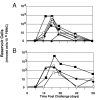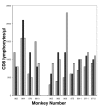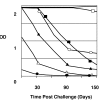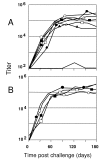Reservoir cells no longer detectable after a heterologous SHIV challenge with the synthetic HIV-1 Tat Oyi vaccine
- PMID: 16441880
- PMCID: PMC1434768
- DOI: 10.1186/1742-4690-3-8
Reservoir cells no longer detectable after a heterologous SHIV challenge with the synthetic HIV-1 Tat Oyi vaccine
Abstract
Background: Extra-cellular roles of Tat might be the main cause of maintenance of HIV-1 infected CD4 T cells or reservoir cells. We developed a synthetic vaccine based on a Tat variant of 101 residues called Tat Oyi, which was identified in HIV infected patients in Africa who did not progress to AIDS. We compared, using rabbits, different adjuvants authorized for human use to test on ELISA the recognition of Tat variants from the five main HIV-1 subtypes. A formulation was tested on macaques followed by a SHIV challenge with a European strain.
Results: Tat Oyi with Montanide or Calcium Phosphate gave rabbit sera able to recognize all Tat variants. Five on seven Tat Oyi vaccinated macaques showed a better control of viremia compared to control macaques and an increase of CD8 T cells was observed only on Tat Oyi vaccinated macaques. Reservoir cells were not detectable at 56 days post-challenge in all Tat Oyi vaccinated macaques but not in the controls.
Conclusion: The Tat Oyi vaccine should be efficient worldwide. No toxicity was observed on rabbits and macaques. We show in vivo that antibodies against Tat could restore the cellular immunity and make it possible the elimination of reservoir cells.
Figures





Similar articles
-
Evaluation in rhesus macaques of Tat and rev-targeted immunization as a preventive vaccine against mucosal challenge with SHIV-BX08.DNA Cell Biol. 2002 Sep;21(9):653-8. doi: 10.1089/104454902760330183. DNA Cell Biol. 2002. PMID: 12396607
-
Vectored Gag and Env but not Tat show efficacy against simian-human immunodeficiency virus 89.6P challenge in Mamu-A*01-negative rhesus monkeys.J Virol. 2005 Oct;79(19):12321-31. doi: 10.1128/JVI.79.19.12321-12331.2005. J Virol. 2005. PMID: 16160159 Free PMC article.
-
HIV-1 vaccines based on replication-competent Tiantan vaccinia protected Chinese rhesus macaques from simian HIV infection.AIDS. 2015 Mar 27;29(6):649-58. doi: 10.1097/QAD.0000000000000595. AIDS. 2015. PMID: 25849828
-
HIV-1 Tat vaccines.Virus Res. 2002 Jan 30;82(1-2):91-101. doi: 10.1016/s0168-1702(01)00393-8. Virus Res. 2002. PMID: 11885958 Review. No abstract available.
-
HIV-1 Tat protein as a potential AIDS vaccine.Nat Med. 1996 Sep;2(9):960-4. doi: 10.1038/nm0996-960. Nat Med. 1996. PMID: 8782444 Review. No abstract available.
Cited by
-
What does the structure-function relationship of the HIV-1 Tat protein teach us about developing an AIDS vaccine?Retrovirology. 2009 May 25;6:50. doi: 10.1186/1742-4690-6-50. Retrovirology. 2009. PMID: 19467159 Free PMC article. Review.
-
Multimodality vaccination against clade C SHIV: partial protection against mucosal challenges with a heterologous tier 2 virus.Vaccine. 2014 Nov 12;32(48):6527-36. doi: 10.1016/j.vaccine.2014.08.065. Epub 2014 Sep 20. Vaccine. 2014. PMID: 25245933 Free PMC article.
-
Synthetic immunotherapy induces HIV virus specific Th1 cytotoxic response and death of an HIV-1 infected human cell line through classic complement activation.Virol J. 2013 Apr 4;10:107. doi: 10.1186/1743-422X-10-107. Virol J. 2013. PMID: 23557359 Free PMC article.
-
Didehydro-Cortistatin A Inhibits HIV-1 by Specifically Binding to the Unstructured Basic Region of Tat.mBio. 2019 Feb 5;10(1):e02662-18. doi: 10.1128/mBio.02662-18. mBio. 2019. PMID: 30723126 Free PMC article.
-
A monoclonal antibody directed against a conformational epitope of the HIV-1 trans-activator (Tat) protein neutralizes cross-clade.J Biol Chem. 2012 Apr 6;287(15):11942-50. doi: 10.1074/jbc.M111.319863. Epub 2012 Feb 23. J Biol Chem. 2012. PMID: 22362765 Free PMC article.
References
-
- Loret EP, Georgel P, Johnson WC, Jr, Ho PS. Circular dichroism and molecular modeling yield a structure for the complex of human immunodeficiency virus type 1 trans-activation response RNA and the binding region of Tat, the trans-acting transcriptional activator. Proc Natl Acad Sci U S A. 1992;89:9734–9738. - PMC - PubMed
Publication types
MeSH terms
Substances
LinkOut - more resources
Full Text Sources
Other Literature Sources
Research Materials

